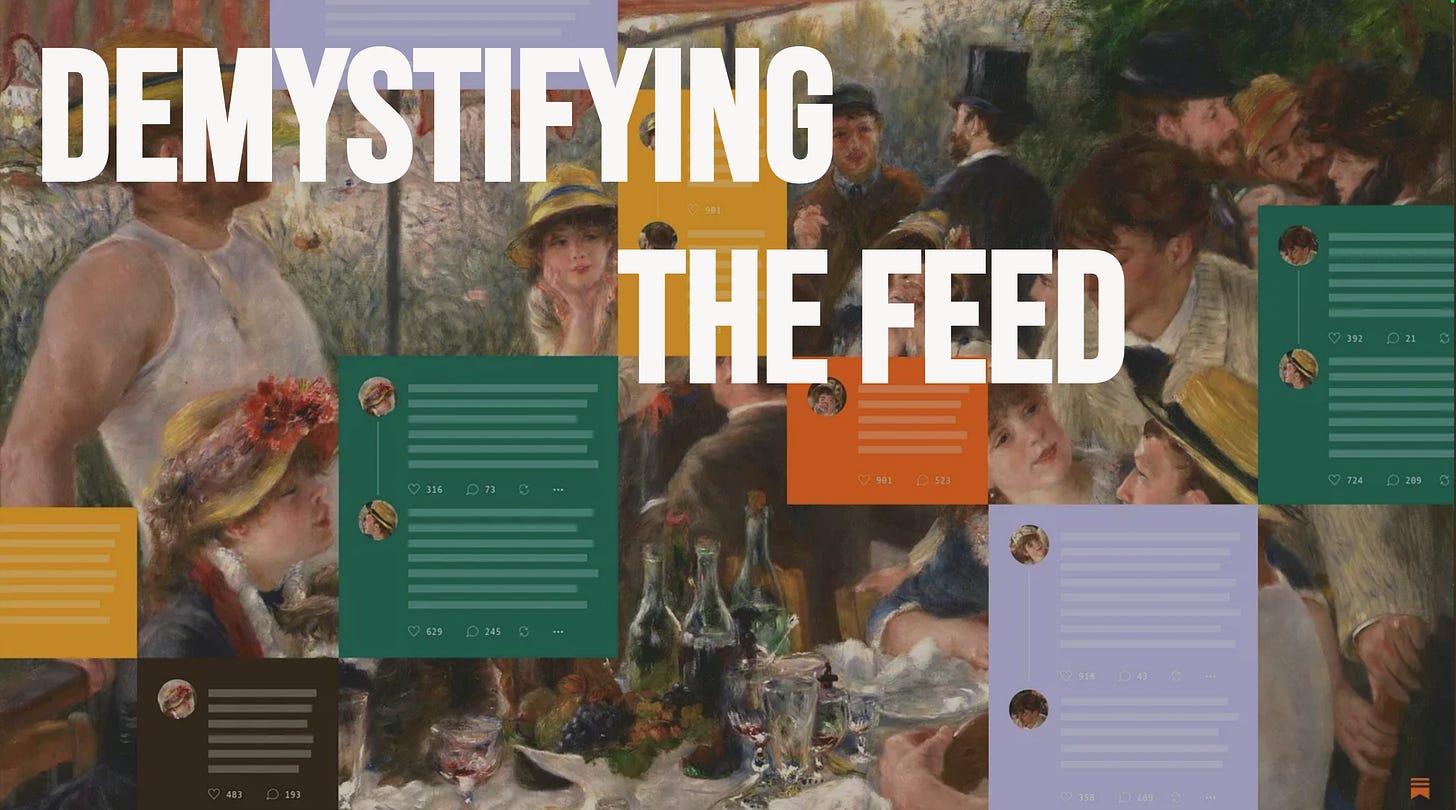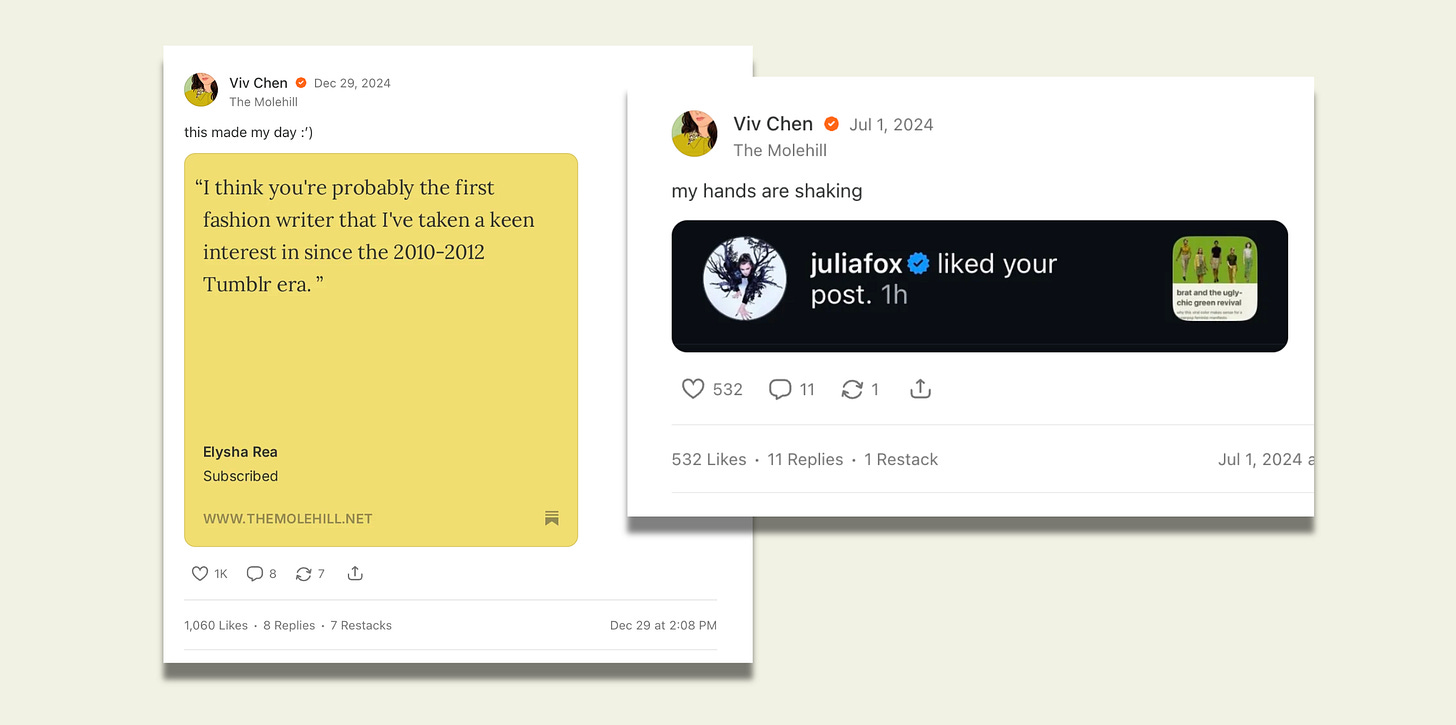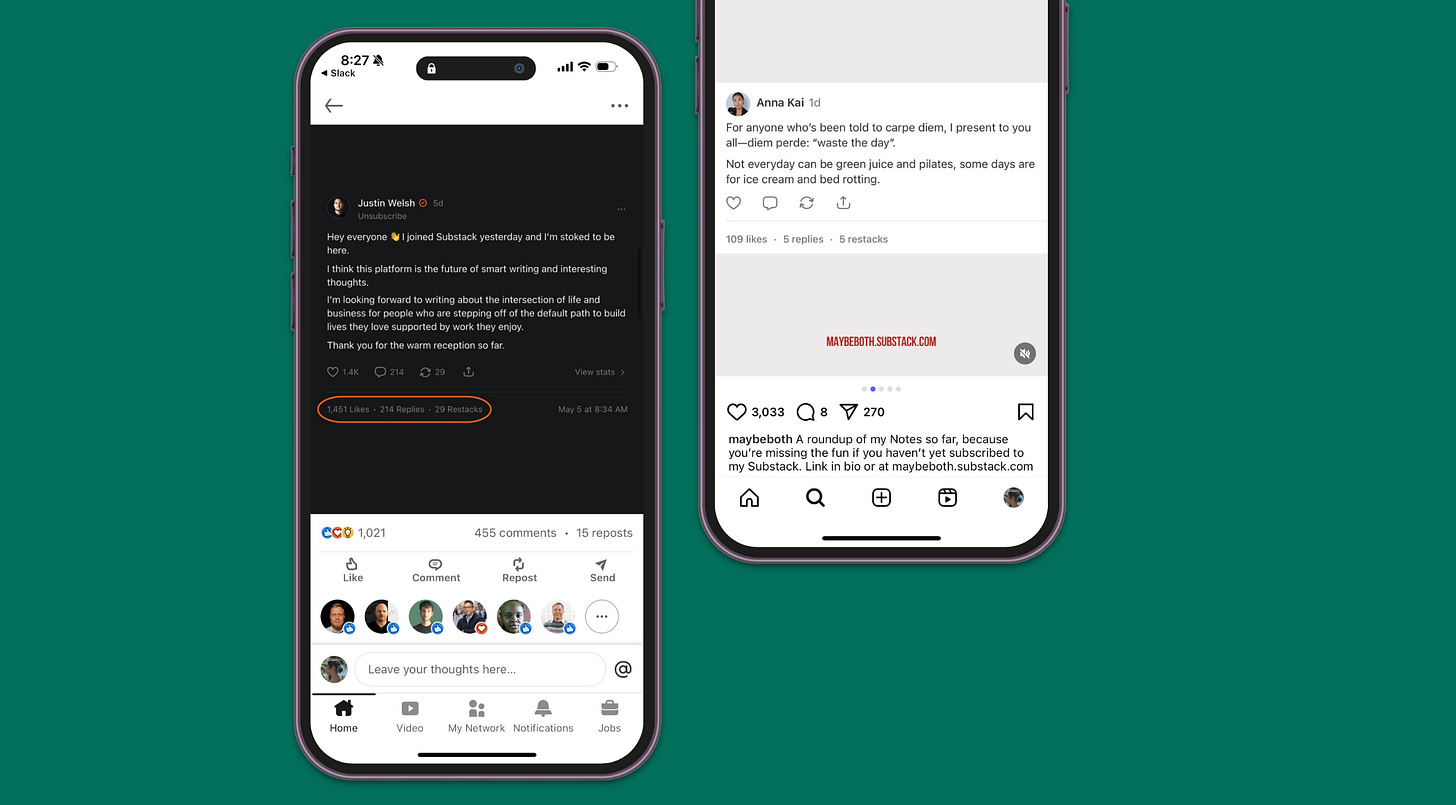Demystifying the feed
Why Substack has a feed, how to use it, and what we have learned from those who are building it.
In the past three months, the Substack app has driven nearly half a million paid subscriptions and more than 32 million free subscriptions to writers and creators. Most of these connections come from the feed, which anchors the app and has become the heartbeat of discovery on Substack. There’s a lot of curiosity about why Substack built the feed and how exactly it’s designed. Members of the Substack team recently spoke to a group of publishers in New York for a look behind the scenes. Here’s what we shared.
Why a feed?
Substack co-founder Hamish McKenzie opened the night by answering the question directly. Writers and creators, he said, have always had to go somewhere online to promote their work and reach new audiences. The problem is that other platforms aren’t built for the success of these creators.
“Social networks have gone in a pretty weird direction. They’re playing a different kind of game, which is based on keeping you stuck in an endless scroll because that’s what their business needs. They need you to never leave the app. They need you to not go seek out a longform post or a deeper experience with a writer you trust. We do nothing to stop you from leaving Substack except show that we are providing enough value that you want to stay. We only make money when you make money, and you have the ability to leave anytime you want. We’re building this social network of discovery and discussion features to give writers and creators more power, and to give consumers the ability to vote for the culture that they want to thrive by voting with their dollars instead of just being turned into sort of mindless bots who scroll a feed.”
The feed’s algorithm is designed with the same principle that guides everything at Substack: helping audiences connect with work they genuinely love while giving publishers the means to build lasting, independent businesses.
Read more from Hamish about the feed: Substack is a social media app
Finding your audience through Notes
Notes, like any gathering place on the internet, attracts all kinds of characters: the memelords, the cat posters, the photo-gallery-loving members of the Tumblr diaspora. There’s no single recipe for success.
But there is one practical throughline: the feed is designed to help you reach beyond your existing audience and point new people to your work.
At the event in New York, members of the team acknowledged that most creatives want to focus on their work, not marketing it. But using Notes to share your value proposition—who you are, what you do, and why someone might care—can help the right audience find you.
Julie Fratantoni, PhD often posts notes that very explicitly share who she is and why she is on Substack. This note drove 32,535 new subscribers and a $4,546 revenue increase.
Anna Lena Feunekes posted a set of illustrations with a crisp explanation of what her newsletter delivers. From this note alone, she picked up nearly 4,000 new subscribers.
Food creator Olivia Noceda posted a short cooking video that organically communicated her value proposition: subscribers get access to her recipes. This specific note brought in 437 new subscribers and $480 in revenue.
Fashion writer Viv Chen has seen roughly 30% of her total subscribers come directly from her notes. We took a closer look at what is driving this growth from the feed.
For Viv, it’s clear that steady, consistent posting has grown her audience even more than occasional virality. She often posts notes teasing ideas, asking for input, and pointing back to longform posts when they publish.
Viv has a strong brand and visual identity associated with her Substack, but many, if not most, of her most successful notes are low-key, casual, and observational.
Just as important, she’s not afraid to highlight others engaging with or celebrating her work. She also does the same for others.
We’ve found that signal-boosting other publishers and joining the wider conversation are both linked to noticeable growth. Restacking and replying to people you genuinely admire—and sharing when they do the same for you—isn’t just good community behavior, it’s one of the most effective ways to grow.
And if you already have audiences elsewhere, sharing your notes off-platform can build on that momentum. Publishers like Justin Welsh, who shares notes to LinkedIn, and Anna Kai, who turns notes into carousel posts on Instagram, use other networks to spark curiosity that brings new subscribers to Substack.
Our top recommendations
Here are our key takeaways to help publishers grow from Notes:
Reach beyond your existing audience. Each note is a chance to introduce your work to someone discovering you for the first time.
Publish consistently. Showing up on a regular basis keeps your work visible and helps new audiences recognize your voice over time.
Be clear about your value. Make it easy for people to understand who you are and what they’ll get by subscribing.
Engage. Reply, restack, and endorse. Notes work best as a conversation.
Cross-post with intention. Share your notes to other platforms to bring people back to Substack.
Demystifying the feed: Q&A with Substack’s head of machine learning
The home feed is designed to connect Substack users with work they’ll love while helping publishers build their businesses. But what does that actually mean in ones and zeroes? We spoke with Mike Cohen, Substack’s head of machine learning, who has been involved since day one in shaping how the feed works. In a Q&A, Mike explained how the algorithm is built, what it’s optimized for, and how it continues to evolve as more publishers use Substack.
In very simple terms, how is our feed designed?
We take a look at who you are as an individual opening the Substack app, where you are in the world, what language you speak, what things you’re subscribed to, who you follow, and what interests you’ve specified, among other things. We try to turn that into a numerical representation so that we can compare it to things that you might want to load in your feed.
How is that different from other platforms?
[Other social feeds] are largely based around time spent. You scroll the feed, and the more time you spend, the more ads you see. Their objective is to decide what ads you’ll click and show them at the right time so you do. Then they hope you pay for whatever you clicked on.
For us, it’s basically the opposite. We don’t care if you are someone who only wants to do longform. If you’re interested in reading, that’s fantastic. If you like short-form text, that’s great too. We’ll keep showing you things you want to see and engage with, and if not, we’ll try something else. If you love video, we’ll show you more of that. Ultimately, there’s no prior belief about what’s good. It’s about what’s best for you, as long as you’re finding things you engage with and eventually subscribe and pay for.
How do you balance helping creators grow without optimizing for virality?
It ultimately boils down to what the objective function of our feed is. The goal is to get people to discover, subscribe, and ideally pay. That’s how we built the feed and how we continue to iterate to make sure that we’re driving subscriptions up.
Tonight we saw some really good examples of writers extracting quotes from other things they’ve enjoyed or restacking. Those actions are great because they all happen on the Substack platform, which means we can understand the full life cycle of behavior and help intersect audiences. What we start with is an understanding of a user, who they follow and subscribe to. If we see overlaps between audiences of different publications, that becomes a virtuous cycle that feeds back into what other people who are similar might enjoy.
Are there any misconceptions about algorithmic feeds that you’d like to clear up?
The word “algorithm” went south at some point, and I get it. It’s a bit of a bummer, because not all algorithms are intentionally bad. The idea behind it is good. We want to pair you with stuff that you like, and that doesn’t seem too bad. What can be bad is what you’re optimizing for. We’re optimizing for sign-ups and subscriptions. If you think that’s bad, then yes, that algorithm is bad. But if you don’t think that’s bad, then it can be good.
You’ve talked about making sure that the feed surfaces things people will find interesting. How do you ensure that people aren’t getting boxed in and only seeing a very specific kind of work?
That’s a challenge we always have to be working on and checking. Every time we make a change or run an experiment, it’s a risk. We always have metrics we’re trying to improve and guardrail metrics to make sure we’re not regressing on things we care about. Breadth of content is something we check to make sure we’re not pigeonholing people forever.
We’ve made changes in the last couple of months to the core retrieval step of the algorithm to make sure that where you are in your reading or feed journey isn’t stagnant. If you’re on a poetry streak, we’ll keep giving you that, but not forever. We want to understand where you are in your flow. We’re trying to make the feed more dynamic and more alive.
Where do you see the feed going in the next year or two?
We’re always trying new things, improving the core algorithms, and running experiments to understand behavior changes when we tweak something. We’ve improved the core retrieval, what content surfaces for you, and we’ll keep iterating to make sure what you’re seeing is the most relevant thing at all times. Basically, we’ll keep hammering until it’s perfect, [though that’s] not possible!
Interview edited for length and clarity.
One last note: Post to the feed! You never know who you might find.





